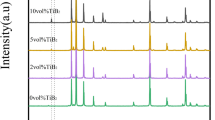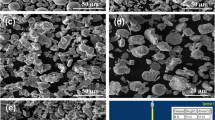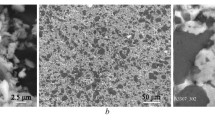The electrical aspects of spark-plasma sintering (SPS) of TiH2–BN and Ti + BN powder mixtures for the production of a TiN–TiB2 ceramic composite material are studied, and the dependence of its properties on direct-current density at the initial stage of sintering is established. To determine the direct-current density, a method for calculating the effective cross-sectional area S eff of the die–sample circuit is proposed. At the initial stage of sintering, the major portion of the current flows through the graphite die because of the resistance of the contacts and the presence of α-BN dielectric. At the final stage of sintering, the current flows mainly through the sintered sample because of the synthesis and densification of the TiN + TiB2 composite and, consequently, the abrupt increases in the conductivity of the sintered sample. Increasing the initial direct-current density during the sintering of TiH x hydride samples leads to an increase in relative density (conductivity), microhardness, fracture toughness, and abrasive wear resistance.










Similar content being viewed by others
References
A. I. Raichenko, Fundamentals of Electric Current Assisted Sintering of Powders [in Russian], Metallurgiya, Moscow (1987).
A. S. Petukhov, I. V. Khobta, A. V. Ragulya, et al., “Reactive electric-discharge sintering of TiN + TiB2,” Powder Metall. Met. Ceram., 46, No. 11–12, 525–532 (2007).
E. Olevsky and L. Froyen, “Constitutive modeling of spark-plasma sintering of conductive materials,” Scr. Mater., 55, 1175–1178 (2006.)
X. Song, X. Liu, and J. Zhang, “Neck formation and self-adjusting mechanism of neck growth of conducting powders in spark plasma sintering,” J. Am. Ceram. Soc., 89, No. 2, 494–500 (2006).
T. Ya. Kosolapova, Handbook of High Temperature Compounds: Properties, Production, Applications, Hemisphere, New York (1990).
B. G. Livshits, V. S. Kraposhin, and Ya. L. Linetskii, Physical Properties of Metals and Alloys [in Russian], Metallurgiya, Moscow (1980).
G. V. Samsonov (ed.), Handbook of Properties of Elements. Part 1. Physical Properties [in Russian], Metallurgiya, Moscow (1976).
M. I. Rogailin and E. F. Chalykh, Handbook of Graphitic Materials [in Russian], Khimiya, Leningrad (1974).
R. A. Andrievskii, Materials Science of Hydrides [in Russian], Metallurgiya, Moscow (1986).
V. A. Lavrenko, M. M. Antonova, and V. Zh. Shemet, Kinetics of Processes in Hydride Systems [in Russian], Naukova Dumka, Kyiv (1992), pp. 8–12.
G. V. Samsonov, L. Ya. Markovskii, A. F. Zhigach, and M. G. Valyashko, Boron, Its Compounds and Alloys [in Russian], Izd. AN USSR, Kyiv (1960).
W. M. Muller, J. P. Blackledge, and G. G. Libowitz, Metal Hydrides, Academic Press, New York (1968), pp. 283–290.
I. I. Osipova, A. M. Kovalchenko, and L. L. Sartinskaya, “Optimization of the composition of nitridic ceramic tool material by tribotechnical tests,” Powder Metall. Met. Ceram., 31, No. 4, 321–324 (1992).
V. S. Zenkov and A. V. Ragulya, “Adsorption-chemical activity and interaction in the boron nitridetitanium hydride system,” Powder Metall. Met. Ceram., 46, No. 5–6, 291–297 (2007).
V. V. Skorokhod, “Theory of the physical properties of porous and composite materials and the principles for control of their microstructure in manufacturing processes,” Powder Metall. Met. Ceram., 34, No. 1–2, 48–63 (1995).
V. I. Odelevskii, “Calculating the generalized conductivity of heterogeneous systems,” Zh. Tekhn. Fiz., 21, No. 6, 667–685 (1951).
Author information
Authors and Affiliations
Corresponding author
Additional information
Translated from Poroshkovaya Metallurgiya, Vol. 50, No. 9–10 (481), pp. 31–42, 2011.
Rights and permissions
About this article
Cite this article
Petukhov, A.S., Khobta, I.V., Ragulya, A.V. et al. Electrical aspects of the spark-plasma sintering of TiN–TiB2 composite. I. Effect of electrical parameters of spark-plasma sintering on the structure and properties of TiN–TiB2 composite. Powder Metall Met Ceram 50, 596–605 (2012). https://doi.org/10.1007/s11106-012-9365-x
Received:
Published:
Issue Date:
DOI: https://doi.org/10.1007/s11106-012-9365-x




